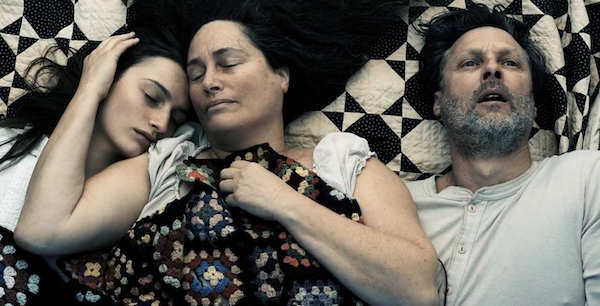Film Review: “Where the Devil Roams” — Dark Carny Horror
By Peg Aloi
The Adams Family may be a low budget regional filmmaking collective, but it continues to raise the bar on horror art cinema.
Where the Devil Roams, directed by the Adams Family. Screening at the Brattle Theater, Cambridge, through November 8.

A scene from Where the Devil Roams.
After Hellbender, their witchy coming-of-age exercise in folk horror thriller, garnered critical acclaim and many enthusiastic fans, the Adams Family (who work as Wonder Wheel Productions, a small filmmaking collective in upstate New York) decided to stretch their indie wings a bit. They have made a full-on period piece and its beautifully chilling. Their latest film is the story of a traveling family of carnival performers set during one of America’s darkest hours, the Great Depression. And, though the narrative contains plenty of anachronistic elements (an excellent, original hard rock soundtrack, for one), the overall aesthetic feels true to the time.
There’s a brief prologue: an archival-looking black-and-white film clip of a well-dressed man with facial piercings and tattoos. He must crawl on his twisted legs to take his place on stage, where he performs a poem before a classy audience. The verse has been inspired by a gruesome story that gives the film its title. The Devil is described as a sinister, sneaky force that moves among us and finds those he can coerce to do his bidding. The next scene is also a prologue of sorts: a family gathering where one young daughter, having murdered one parent, passes her weapon to her younger sister Maggie, who murders the other. There’s no explanation for how these bad seeds came to be this way, but one suspects the Devil, however one interprets him, may have had a hand in it.
Moving some years forward, a teenage girl named Eve (Zelda Adams) walks through a small town to a general store, where she pockets an apple. She runs into a handsome man who whispers he might cut off her fingers for her deed. They’re both part of the traveling carnival. Eve performs with her parents Maggie (all grown up!) and Seven (John Adams). Maggie was a nurse during the war, caring for Seven, who was a medic, and now suffers traumatic flashbacks. They run a carnival game when they are not presenting their odd stage act. Eve is dressed as an angel, all in white, while Maggie and Seven, dressed in black, perform robotic movements as Eve sings a plaintive song. Their act is nowhere near as popular as the performance of Mr. Tipps (Sam Rodd), whose act consists of preaching hellfire, culminating in his cutting off his own fingers with a large pair of scissors and dropping them into a bucket. Other carnies assume he’s a magician, but after Eve stumbles upon his secret she begins to experiment with similar techniques.
Despite their stints helping others in WWI, Maggie and Seven’s lives as traveling carnies now revolve around acts of violence. Sometimes engaging in calculated expressions of revenge, sometimes random bouts of butchery, they even spread their brutal carnage in the presence of kind strangers. Maggie covers Seven’s eyes so he won’t witness the atrocities: Maggie does the killing while Eve takes photos on an old box camera. The mayhem feels like a ritual they’ve been practicing for years but have yet to perfect. They travel through cold, sparse country, sleeping where they can and often starving. Humanity around them has been corrupted where ever they go: an arbitrary morality prevails over this wintry landscape.
As time passes, their carnival act becomes increasingly bloody and macabre, and that attracts enthusiastic audiences. Despite the glow of their popular success, there’s a sense that the ritual sacrifices cannot continue as they have. Seven seems troubled by the increasing depravity, while Maggie seems untroubled as she invents songs on the ukulele. A silent Eve just watches and learns. The pressure builds, inexorably and horrifyingly, culminating in unspeakable acts of butchery, leading to a final scene that is as grotesque as it is poetic.
The film’s plot wobbles at times and the dialogue sometimes sounds awkward. But, within the overall framework of the film, these flaws are smoothed out by an impressive mise-en-scène. Artful tableaux transport the viewer to a place and time where strange magics and petty evils prevail in a landscape of superstition, trauma, and decay. The trio of family performers have evolved an intimate shorthand with each other, and the alluring personae of their carnival cohorts add disturbing atmosphere. The stark cinematography transforms the wooded regions of the Catskill to a sparse yet wild place of grey forests and lonely country roads. The lyrical photography has been so desaturated it often looks monochromatic, the production design is tight, stunning and distinctive.
The Adams Family may be a low budget regional filmmaking collective, but it continues to raise the bar on horror art cinema. This talented clan is making films that look and feel like nothing anyone else has done or seen before. Where the Devil Roams will have horror fans talking for years to come.
Peg Aloi is a former film critic for the Boston Phoenix and member of the Boston Society of Film Critics, the Critics Choice Awards, and the Alliance for Women Film Journalists. She taught film studies in Boston for over a decade. She writes on film, TV, and culture for web publications like Time, Vice, Polygon, Bustle, Mic, Orlando Weekly, and Bloody Disgusting. Her blog “The Witching Hour” can be found on substack.
Tagged: John Adams, Lulu Adams, Sam Rodd, The Adams Family, Toby Poser, Where the Devil Roams
